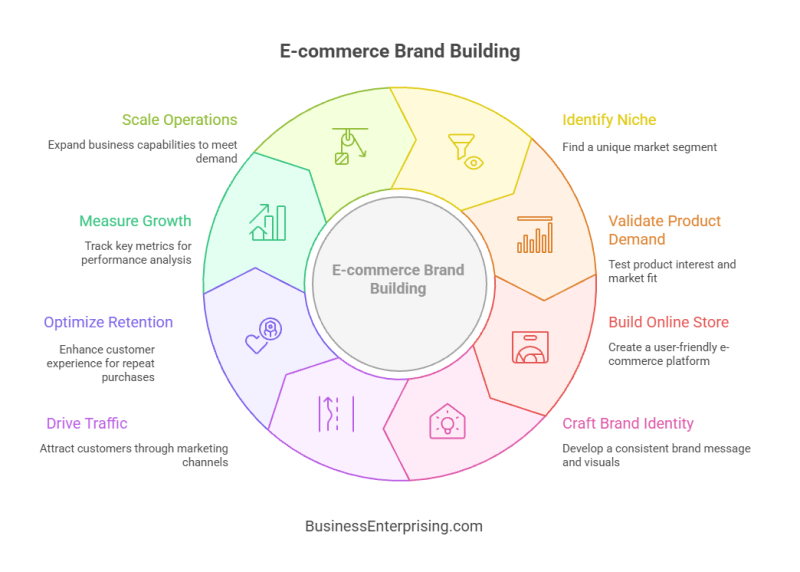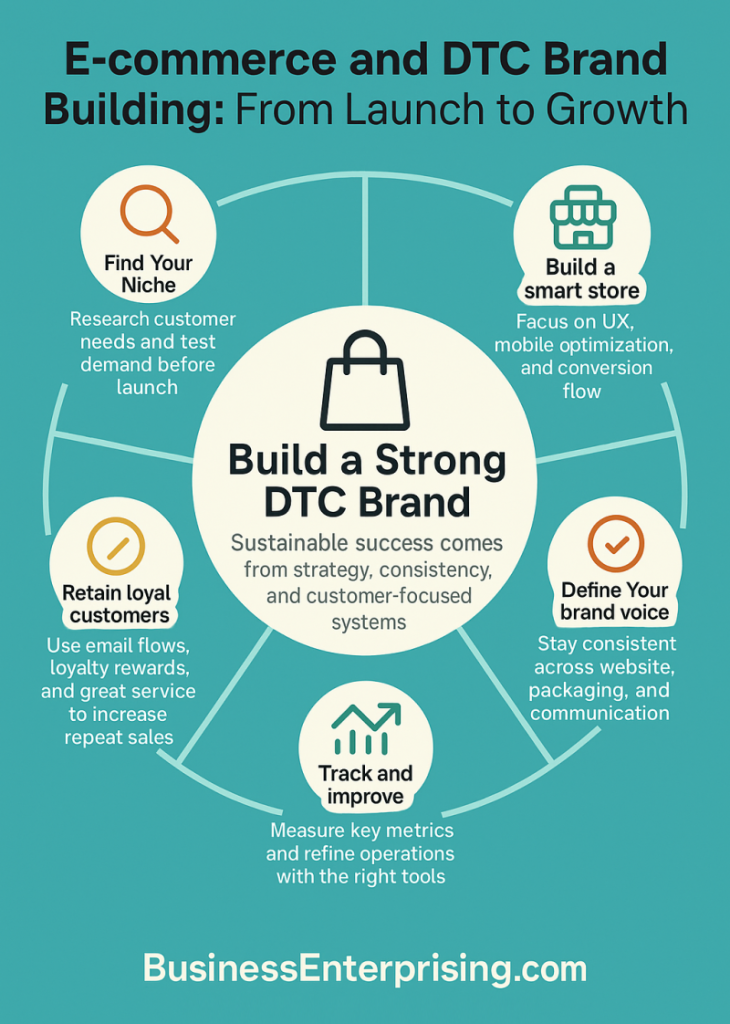
Therefore, it helps to start with a clear plan. You should define your niche, learn your market, and test your product idea. Additionally, building your store with the right tools makes it easier to manage growth later. Every decision you make early affects how your business performs later.
Customer experience plays a bigger role than many people expect. From your website design to your emails and shipping boxes, everything should feel connected. Therefore, the way you package your product matters as much as how you advertise it.
You don’t need to do everything at once. However, you should stay focused on what builds trust and supports consistency. A smooth checkout, clear return policy, and fast support response help more than any sale. Additionally, a good experience turns one-time buyers into repeat customers.
Marketing also plays a role in long-term growth. Organic and paid channels both have value. Therefore, you should balance short-term gains with lasting systems. Email, SEO, and influencer marketing all support different parts of your funnel. Starting with a strong foundation gives your brand room to grow. When your store, message, and service work together, your business becomes easier to run. That’s how smart brands scale without losing quality.
Identifying a Niche and Validating Product Demand
Before you launch a product, you need to know if people want it. That means finding a niche and testing demand first. Many brands skip this step and later struggle to gain traction.
Start by looking at what problems your product solves. Then check if people already spend money on similar solutions. Search forums, read reviews, and pay attention to how people describe their needs. Additionally, look for gaps where existing products fall short.
You should also study your competitors. Review their websites, pricing, reviews, and messaging. Therefore, you can spot what works and where your offer might stand out. Strong competition means a market exists, but your product needs a clear reason to compete.
Next, test your idea with a small group. You can use landing pages, preorders, or sample campaigns to measure interest. Additionally, surveys and feedback forms help clarify what people expect from your product. That feedback gives you direction before you invest more time or money.
Product-market fit means people want what you sell and are willing to pay for it. You don’t need a large audience right away. However, you need enough interest to prove your offer has value.
E-commerce and DTC brand building starts with a solid foundation. That begins by knowing your customer, understanding demand, and confirming the market supports your idea. When you start with proof instead of guesswork, your chances of long-term success improve.
Building a Conversion-Focused Online Store
Your online store should do more than look good. It needs to guide visitors toward taking action without slowing them down. Therefore, every design choice should support clarity and ease of use.
Start with a clean layout that loads quickly on both desktop and mobile. Many people shop from their phones. If your mobile site is slow or hard to read, they will leave fast. Additionally, buttons should be large enough to tap and placed where users expect to find them.
Product pages need clear photos, short descriptions, and trust signals like reviews or return info. Avoid clutter. Let your content answer common questions before people have to ask. Therefore, fewer doubts lead to more conversions.
Checkout should feel fast and familiar. Reduce the number of steps and remove anything that doesn’t help close the sale. Offer multiple payment options and avoid surprises like hidden fees. Additionally, use autofill and guest checkout to make things easier.
Shopify and WooCommerce are both solid platforms. Shopify works well for speed and ease. WooCommerce offers more control and flexibility. Therefore, your choice depends on your budget, technical comfort, and how much you want to customize.
E-commerce and DTC brand building depends on your store doing its job. It must guide people from curiosity to purchase without friction. When your site works well, customers stay longer and buy more often. Start simple, test often, and let your data shape improvements.
Crafting a Distinct Brand Identity and Voice
Your brand is more than your logo or colors. It’s how people recognize you and what they expect from you. Therefore, every element you present should match the same tone and message.
Visuals set the first impression. That includes your website design, product photos, packaging, and even social posts. Keep your colors, fonts, and layout consistent across all platforms. Additionally, use the same image style so your content feels unified.
Voice matters just as much. It should reflect your values and speak the way your customers think. Some brands use a friendly tone. Others sound more direct or technical. Choose a voice that fits your audience and stay with it. Therefore, your emails, product pages, and social captions all need to sound like they come from the same source.
Messaging connects the visuals and voice. Talk about your product the same way across every channel. Highlight the same benefits. Repeat the same phrases that customers already recognize. Additionally, match your tone when you respond to reviews or support requests.
E-commerce and DTC brand building depends on trust and familiarity. When people see and hear a consistent message, they feel more confident. That confidence makes them more likely to buy and return.
Building a distinct brand identity doesn’t require fancy tools. It takes clear thinking, repeatable systems, and attention to detail. Review your store, emails, and packaging side by side. Then adjust anything that doesn’t match. Small fixes add up over time.
Driving Traffic Through Organic and Paid Channels
Your website means nothing if no one sees it. Traffic drives sales, so you need reliable ways to bring people in. That means combining both organic and paid efforts to build momentum.
Content marketing gives you a long-term way to earn attention. Blog posts, how-to guides, and product tips help your audience solve problems. Therefore, you build trust before asking for a sale. Additionally, strong content gives you material to repurpose across social platforms and emails.
SEO helps people find you through search. Focus on keywords tied to what buyers already want. Structure your pages so search engines can read them clearly. Additionally, use clean URLs, short titles, and strong meta descriptions to get more clicks.
Email still works because it speaks directly to your customers. Collect emails through popups, checkout pages, or gated content. Then send helpful updates, offers, or product info. Therefore, you stay on their radar without needing ads every time.
Paid channels speed things up. Run social ads that match your audience’s habits. Use Meta, Google, or TikTok depending on where your customers spend time. Additionally, retarget visitors who already showed interest but didn’t convert.
Influencer partnerships help extend reach through trusted voices. Choose people who speak to your niche, not those with the largest following. You want credibility, not noise. Therefore, focus on engagement and audience fit more than vanity metrics.
E-commerce and DTC brand building needs a steady stream of qualified traffic. Organic methods grow slowly but stay reliable. Paid methods cost more but work fast. When you balance both, your store gains attention and keeps it.
Optimizing Retention Through Customer Experience
Getting someone to buy once is a win, but getting them to buy again builds your brand. Repeat customers cost less to reach and spend more over time. Therefore, customer experience should be part of your marketing plan from the start.
Start with email flows that speak to your customer’s needs. A welcome series sets the tone. Follow-ups can offer tips, reminders, or upsells. Additionally, segment your emails by past purchases or behavior. That way, your messages feel relevant instead of random.
Loyalty programs give people a reason to come back. You can offer points, discounts, or early access to new products. Make it simple to join and easy to use. Additionally, promote your program often so it stays top of mind.
Customer service shapes how people remember your brand. Answer questions quickly and clearly. Make returns easy and instructions clear. Therefore, you reduce friction and increase satisfaction. Happy customers often turn into repeat buyers without needing more ads.
Automation helps, but you still need a human touch. Personalized messages and helpful responses go a long way. Additionally, tools like chat support, post-purchase emails, and review requests show your customers you care.
E-commerce and DTC brand building depends on long-term loyalty, not one-time wins. Focus on the people who already bought from you. Treat them well and stay in touch. Over time, those relationships become your best marketing asset.
Measuring Growth and Scaling Operations
Growth only matters if it leads somewhere sustainable. That means tracking the right numbers and building systems to support demand. Therefore, before you scale, you need a clear view of what’s working and what’s not.
Start by watching your key metrics. Track average order value, customer acquisition cost, and repeat purchase rate. Additionally, keep an eye on margins and return rates. These numbers show where your brand is strong and where it might need attention.
Inventory and fulfillment tools keep your operations on track. Use software that syncs with your store, updates stock in real time, and manages shipping zones. Therefore, you avoid overselling and late deliveries. Additionally, choose warehouse partners who offer clear reporting and flexible capacity.
Scaling doesn’t mean doing everything bigger. It means doing more of what works while keeping service consistent. That includes automating repeat tasks and tightening supply chains. However, you should still check in regularly to catch small problems before they grow.
Protect your brand as you grow. Keep packaging, communication, and customer service consistent. Additionally, document your processes so your team stays aligned. Brand trust often weakens when growth moves faster than systems can support.
E-commerce and DTC brand building depends on solid operations beneath your marketing. Growth without structure leads to mistakes that can cost you loyal customers. Therefore, plan to scale with care, not speed. You don’t need perfect tools to grow well. You need a clear view of your numbers and a system that matches your pace. That approach supports success without sacrificing quality.
Conclusion
Building a brand takes more than a product and a store. It takes structure, planning, and consistent follow-through across every step. You need clear systems that support both customer experience and operational growth. Therefore, your success depends on more than marketing alone.
Start by focusing on the basics. Know your audience, offer something they want, and deliver it without confusion. Additionally, track your results so you can make better decisions over time. When your systems are steady, your brand becomes easier to grow.
E-commerce and DTC brand building works best when every part of the process supports the next. Your marketing should match your product. Your service should reflect your message. Therefore, your entire business should feel like one clear experience from start to finish.
You don’t need a large team to get results. What matters is using tools that fit your goals and pace. Additionally, stay focused on what brings customers back. A well-timed email, a fast delivery, or a helpful response often makes a lasting difference.
Each part of your brand should work together without friction. That includes your store, support, packaging, and communication. When people trust you, they buy again. When systems run smoothly, you scale with less stress. Therefore, keep things simple, steady, and thoughtful. Good decisions made early support growth without losing quality. That’s how long-term businesses take shape and stay strong.



